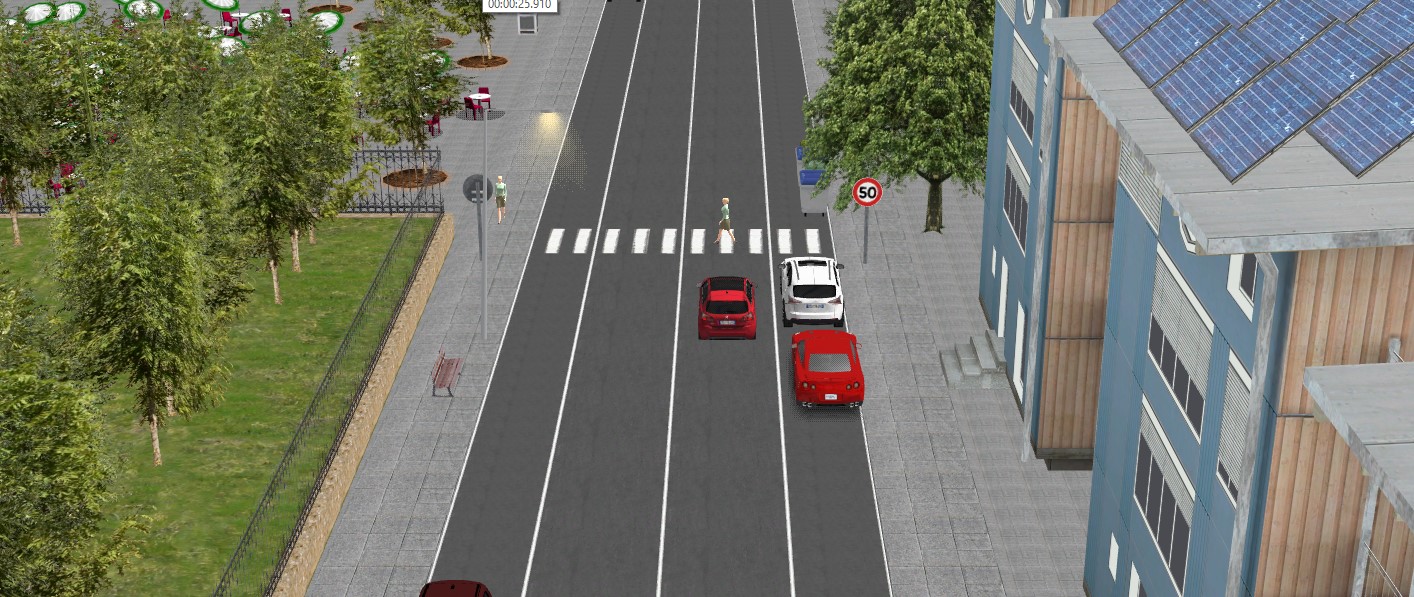CONTEXT
In the complex and dynamic interaction between drivers and pedestrians, the identification of pedestrians’ intentions is a key factor. This is not a trivial task for the driver, since it requests the integration of sensorial, cognitive, and decisional features. One important example in this sense is the anticipation of crosswalks, which can happen both in correspondence with the proper road signals (e.g., streetlights or pedestrian crossings). Here the driver has to integrate sensorial and cognitive information, resulting in a motor activation in preparation for deceleration or a brake. From a neural perspective, the dorsolateral prefrontal cortex (DLPFC) has been recognized to have a prominent role in the anticipation of complex behavior.
CHALLENGE
To detect a potential difference in behavioral and neural activation (DLPFC) facing predictable (with road signal) and unpredictable (without road signal) crosswalks. Operatively, it requests to transmit SCANeR trigger events to the fNIRS signal detection software.
SOLUTION
A neuro-behavioral driving simulation experiment was conducted on SCANeR 2021. 2. The development of a Simulink ‘bridge’ model to allow the communication between SCANeR and Aurora fNIRS software.
BENEFITS
The present application has the potential to shed new light on the behavioral and neural mechanism of driver behavior, especially in the driver’s preparation for predicted or unpredicted pedestrian crosswalks in a simulated urban environment. The possibility to implement a Simulink model to allow the communication between SCANeR and neuropsychological software will enlarge the applicability of SCANeR in experimental research.
USER SOLUTION

Figure 1
In the study, younger (from 18 to 35) and older drivers (from 36 to 50) were compared in a driving simulation task, settled in an urban environment. The experimental equipment consisted of a Logitech G29 as a driving device, a wireless fNIRS (Nirsport2) with 16 light sources, and 16 detectors, placed on the participant’s forehand with the help of a special headband, in consideration of the brain area of interest (prefrontal cortex). The experiment was conducted in a CAVE (Cave Automatic Virtual Environment) simulation environment, with a separated control room.
Before the experiment, a series of questionnaires were administered, concerning propensity towards technology, driving style, hemispheric brain dominance, DASS (Depression, Anxiety, Stress Scale), and the simulation sickness questionnaire. During the experiment, the participants were requested to drive the vehicle following the programmed track and react to events that could potentially happen. Along the track, 25 pedestrian crosswalks were programmed, 16 predicted (with pedestrian crossing) and 7 unpredicted (without pedestrian crossing). Participants had to react to each event coherently with (i) their actual speed, (ii) the pedestrian speed, and (iii) their perception of risk in that particular situation (Figure 1). The participant had to proceed straight for almost all the driving activity, aside from two turns. This decision was limited by the high simulation sickness that we have noticed in the CAVE simulation environment, which creates a highly immersive environment that has an impact on the participant’s well-being in the medium-long term.
Each pedestrian crossing was programmed on SCANeR setting a series of triggers alongside the track, activated by the participant’s vehicle itself. When the vehicle triggered a particular area, the pedestrian started crossing the road. The triggers were also useful to diversify the traffic environment, changing the type of vehicles from the opposite direction of travel and characterizing the landscape. The participant’s lane was not highly populated, in order to avoid brakes unrelated to the pedestrians’ behavior.
In order to allow communication between SCANeR and Simulink, we have taken advantage of the MatLab files provided by SCANeR’s APIs (setSCANeRPath.m, setupSCANeR.m). This solution gave us the possibility to create a new Simulink module on our SCANeR configuration, and develop a number of export channels to detect the events of interest (e.g., vehicle in the braking area, contact with the pedestrian, etc.). These channels were added – conjunctly with Time Markers – in the SCANeR script in correspondence with the events of interest. Once the communication between SCANeR and Matlab was activated, a Simulink model was developed to allow the transmission of the signal to the fNIRS software. This model collected the variation of values of our Boolean export channels (0-1), and through a connection via ethernet code sent out the signal to the Aurora software every time an event took place.
In Aurora, the input merged with the fNIRS signal, specifying the window of interest for the evaluation of potential hemodynamic variation in preparation of predicted or unpredicted pedestrian crosswalks. These inputs have pivotal importance in the data processing and data analysis phases since give us the chance to compare the hemodynamic activity with each specific event computed in the driving simulation task.
After the experiment, the participant was freed by the fNIRS headband and was requested to answer the NASA TLX scale and the simulation sickness questionnaire.
QUOTE/ KEY NUMBERS
Anticipating the identification of pedestrians’ intentions is a complex task for the driver while driving. Here sensorial and cognitive information has to be properly integrated in a limited period of time, to prepare the proper motor activation in preparation for a safe maneuver.
NEXT STEPS
Compare the evidence collected on the topic with the present human-driving application in the autonomous driving context, searching for potential hemodynamic and psychophysiological differences in the preparation of pedestrian crosswalks between traditional drivers and autonomous vehicles’ passengers.
